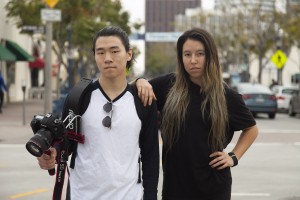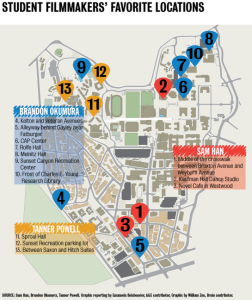Tanner Powell arranged to shoot at Piazza D’Angelo, an Italian restaurant near San Francisco, certain of having a smooth shooting day. However, the sound of sprinklers and leaf blowers disrupted the filming of “Working Class Heroes” because the owner had forgotten to warn the employee in charge of opening for business that morning.
“It went terribly, and we ended up having to dub over it afterwards,” said Powell, a second-year undeclared student.
Shooting at public locations, he said, often comes with challenges for student filmmakers with limited budgets. They are challenged to find locations that fit their script but are also legal and practical to shoot at.
Brandon Okumura, a UCLA alumnus, is currently finishing “Vignettes,” a 10-episode series about a couple who deals with depression. Most of the scenes were shot in his friends’ Veteran Avenue apartments, as private locations are usually free and easy to control while filming.
Last year, while he was shooting a scene for one episode, “Dead Ends,” he was removed from a table in front of the Charles E. Young Research Library in the middle of shooting because a group of high school students needed to have lunch there.

In about three weeks, Powell will start shooting “Daylight in the Night Time,” a film noir parody about a man who stole a bunch of coffee beans. Like Okumura, Powell plans on shooting most scenes in apartments, but also wants to include shots of the thief wandering around Los Angeles.
Sam Han, another filmmaker and a first-year English student, is shooting a music video for the music band FYS on Friday. The track is called “Trance Formation” and the video will be shot at Baldwin Hills in South Los Angeles, a location that is not too crowded and will thus facilitate shooting, he said.
Okumura and Nick O’Brien, a first-year film student who filmed “Cole: The Movie,” a biography of one of his classmates during fall quarter, use their personal incomes to cover some of the expenses.
“(My financing) is a double-edged sword,” O’Brien said. “I use filmmaking to help offset the cost of making movies.”
In order to deal with the filming costs, Powell believes in being open to making changes to the script. When he was making “Working Class Heroes,” rather than have actors run away with a briefcase full of cash, he opted for a burlap sack instead because he wasn’t able to obtain a briefcase. He said the substitution unexpectedly worked well, as it enhanced the comedic aspect of the scene.
Since making movies on a student budget is very costly, filming in public settings is almost inevitable, Han said.
Last quarter, Han shot a dance video for a friend and submitted it to the world arts and cultures/dance department’s “Yes To Bodies” dance showcase. The video featured Amanda Adams, second-year world arts and cultures student, performing a contemporary routine in the middle of the crosswalk between Broxton Avenue and Weyburn Avenue, at three different times of day.
“It was really fun keeping track of the traffic lights as we ran on and off the street,” Han said.
However, filming in public often comes with challenges, Okumura said.
While working on “Working Class Heroes,” Powell was disrupted while shooting at a water tower near San Francisco. He was forced to leave the public location because a woman claimed that the tower was on her private property. He ended up moving to the other side of the tower, which was hidden, to finish the shot.
Han, Powell and Okumura agree that the best way to deal with filming in public locations is to adopt a theater-like approach, holding extensive rehearsals beforehand in order to minimize the time on set.
Currently, Han is working on a movie that he is hoping to shoot at Novel Cafe in Westwood, but has not received confirmation yet. He plans to compensate for the shorter filming schedule by shooting for two days rather than four, and rehearsing extensively beforehand.
However, for students in the UCLA School of Theater, Film and Television, finding locations to film is not as difficult because they have access to TFT’s advanced facilities and equipment for their class projects.
Okumura had to create his own light set two years ago using PVC pipes he bought at Home Depot.
“They’re really bulky but they’re mine,” he said. “I like to own the material I use to shoot.”
For student filmmakers like Okumura, building sets is one of the challenges of making a movie on a student budget. But overall, he said, making movies in a college setting is a positive experience; it’s a time and place where students can develop their critical thinking and creativity and meet people who share similar interests.
“The reason I came to UCLA was because of its film community,” Okumura said. “There are a lot of independent filmmakers here and we try to help each other out.”

